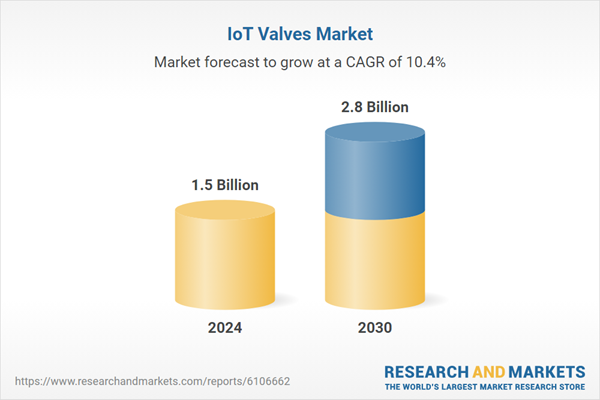Global IoT Valves Market - Key Trends & Drivers Summarized
Why Are IoT Valves Redefining Operational Efficiency in Industrial Systems?
IoT valves are fundamentally transforming the way industries manage and monitor fluid and gas control systems by integrating smart sensors, connectivity features, and data analytics into traditional valve infrastructure. These intelligent valves provide real-time monitoring, remote control, and predictive maintenance capabilities, enabling companies to make informed decisions and respond proactively to system anomalies. The shift from manual or semi-automated systems to fully connected IoT-based valve networks is reducing operational downtime, enhancing process safety, and optimizing energy usage across sectors such as oil and gas, water treatment, chemical processing, and HVAC. By continuously collecting data on parameters like flow rate, pressure, temperature, and vibration, IoT valves enable the automation of critical control functions without the need for constant human supervision. This increased automation helps reduce labor costs, prevent equipment failure, and ensure compliance with strict regulatory standards. The ability to remotely shut off valves during emergency situations or operational errors further adds a layer of safety that traditional systems cannot offer. As smart factories and Industry 4.0 initiatives gain momentum, IoT valves are becoming central to the creation of fully digitized, self-correcting industrial ecosystems where data drives every aspect of operation and maintenance. Their growing adoption reflects a broader trend toward real-time process intelligence and automation that is reshaping the future of industrial management.How Are Technological Advancements Enhancing the Functionality of IoT Valves?
The functionality of IoT valves is being greatly enhanced by advances in sensor technology, wireless communication protocols, and data processing capabilities. Miniaturized sensors embedded within valves now offer precise and continuous readings of internal conditions, while edge computing capabilities allow for data to be processed locally, reducing latency and bandwidth demands. IoT valves are increasingly equipped with long-range wireless connectivity such as LoRaWAN, NB-IoT, and 5G, which enables reliable transmission of data across large industrial complexes and remote field locations. Integration with SCADA systems and cloud-based platforms allows for centralized control, remote diagnostics, and seamless coordination across multiple sites. Artificial intelligence and machine learning are being integrated into IoT valve platforms to detect performance anomalies, predict maintenance needs, and optimize flow parameters based on historical and real-time data. Interoperability standards are evolving to support plug-and-play functionality across equipment from different manufacturers, promoting easier deployment and system integration. Advanced power management techniques, including energy harvesting and ultra-low-power electronics, are extending battery life and enabling the operation of valves in off-grid or difficult-to-access environments. These innovations are not only increasing the intelligence and adaptability of valve systems but are also reducing the cost and complexity of implementation, making smart valve technology accessible to a broader range of industries and applications. As these technologies mature, IoT valves are expected to play an even more strategic role in enabling autonomous operations and next-generation industrial control systems.How Do Industry-Specific Requirements Influence the Design and Deployment of IoT Valves?
The design and deployment of IoT valves are highly influenced by the unique operational demands and regulatory environments of different industries, leading to diverse configurations and use cases. In the oil and gas sector, for example, IoT valves must withstand extreme pressures, corrosive substances, and explosive atmospheres while ensuring seamless communication with remote control centers. Their role in preventing leaks and blowouts through automated shutdown mechanisms is critical to maintaining operational safety and environmental compliance. In water and wastewater management, IoT valves are deployed to monitor flow and detect leaks across distributed pipeline networks, enabling municipalities to reduce water loss and improve resource efficiency. Smart irrigation systems in agriculture use IoT valves to manage water distribution based on soil moisture and weather data, helping farmers optimize crop yields and conserve water. In HVAC systems, these valves regulate coolant flow and temperature in response to occupancy patterns and building management algorithms, improving energy efficiency and indoor comfort. The pharmaceutical and food industries require sanitary designs and real-time monitoring to ensure product safety and adherence to strict quality standards. The ability to tailor valve functionality, communication protocols, and housing materials to specific environmental and operational conditions is essential for successful deployment. Furthermore, integration with asset management and enterprise resource planning systems ensures that valve performance data contributes to broader organizational decision-making. These industry-specific requirements underscore the need for modular, scalable, and customizable IoT valve solutions that can meet the demands of diverse applications while maintaining reliability and regulatory compliance.What Is Driving the Rapid Growth of the Global IoT Valves Market?
The growth in the IoT valves market is driven by several key factors linked to industrial digitization, efficiency mandates, regulatory pressures, and rising infrastructure investment. One of the primary growth drivers is the global trend toward Industry 4.0 and the digital transformation of manufacturing and utility operations, which rely heavily on smart components to achieve real-time visibility and automation. The need to reduce unplanned downtime and increase operational efficiency is prompting companies to replace or retrofit conventional valve systems with intelligent, connected alternatives. Environmental regulations and sustainability goals are also fueling adoption, as IoT valves help monitor emissions, detect leaks, and manage resource consumption with greater precision. Expanding infrastructure development in smart cities, clean energy, and utilities is creating a robust demand for valves that support remote control, data analytics, and seamless integration with IoT ecosystems. Additionally, the proliferation of cloud computing, edge intelligence, and advanced analytics platforms is lowering the barrier to entry for deploying smart valve systems, making them viable for mid-sized and smaller enterprises. Supply chain modernization and predictive maintenance programs are also encouraging adoption, as companies seek to minimize costs and extend the lifespan of critical assets. As cybersecurity frameworks for industrial IoT mature, concerns over data integrity and system protection are being addressed, further boosting market confidence. Collectively, these factors are generating strong momentum for the IoT valves market across multiple sectors, positioning it as a foundational technology for the next generation of intelligent infrastructure and industrial automation.Report Scope
The report analyzes the IoT Valves market, presented in terms of market value (US$). The analysis covers the key segments and geographic regions outlined below:- Segments: Connectivity (Wired Connectivity, Wireless Connectivity); Type (IoT Ball Valves, IoT Butterfly Valves, IoT Safety Valves); End-Use (Industrial End-Use, Commercial End-Use, Residential End-Use).
- Geographic Regions/Countries: World; United States; Canada; Japan; China; Europe (France; Germany; Italy; United Kingdom; and Rest of Europe); Asia-Pacific; Rest of World.
Key Insights:
- Market Growth: Understand the significant growth trajectory of the Wired Connectivity segment, which is expected to reach US$1.9 Billion by 2030 with a CAGR of a 11.5%. The Wireless Connectivity segment is also set to grow at 8.2% CAGR over the analysis period.
- Regional Analysis: Gain insights into the U.S. market, valued at $404.2 Million in 2024, and China, forecasted to grow at an impressive 9.4% CAGR to reach $427.9 Million by 2030. Discover growth trends in other key regions, including Japan, Canada, Germany, and the Asia-Pacific.
Why You Should Buy This Report:
- Detailed Market Analysis: Access a thorough analysis of the Global IoT Valves Market, covering all major geographic regions and market segments.
- Competitive Insights: Get an overview of the competitive landscape, including the market presence of major players across different geographies.
- Future Trends and Drivers: Understand the key trends and drivers shaping the future of the Global IoT Valves Market.
- Actionable Insights: Benefit from actionable insights that can help you identify new revenue opportunities and make strategic business decisions.
Key Questions Answered:
- How is the Global IoT Valves Market expected to evolve by 2030?
- What are the main drivers and restraints affecting the market?
- Which market segments will grow the most over the forecast period?
- How will market shares for different regions and segments change by 2030?
- Who are the leading players in the market, and what are their prospects?
Report Features:
- Comprehensive Market Data: Independent analysis of annual sales and market forecasts in US$ Million from 2024 to 2030.
- In-Depth Regional Analysis: Detailed insights into key markets, including the U.S., China, Japan, Canada, Europe, Asia-Pacific, Latin America, Middle East, and Africa.
- Company Profiles: Coverage of players such as 360imaging Inc., Alpha Omega Engineering, Axion BioSystems, Blackrock Neurotech, BrainVision LLC and more.
- Complimentary Updates: Receive free report updates for one year to keep you informed of the latest market developments.
Some of the 42 companies featured in this IoT Valves market report include:
- AVK Holding A/S
- BELIMO Holding AG
- Cavagna Group
- Claval Company
- CIRCOR International Inc.
- Danfoss A/S
- Emerson Electric Co.
- Endress+Hauser Group
- Flowserve Corporation
- Festo SE & Co. KG
- Forbes Marshall
- Honeywell International Inc.
- IMI plc
- Johnson Controls International plc
- KITZ Corporation
- Metso Corporation
- Parker Hannifin Corporation
- Rotork plc
- SAMSON AG
- Siemens AG
This edition integrates the latest global trade and economic shifts into comprehensive market analysis. Key updates include:
- Tariff and Trade Impact: Insights into global tariff negotiations across 180+ countries, with analysis of supply chain turbulence, sourcing disruptions, and geographic realignment. Special focus on 2025 as a pivotal year for trade tensions, including updated perspectives on the Trump-era tariffs.
- Adjusted Forecasts and Analytics: Revised global and regional market forecasts through 2030, incorporating tariff effects, economic uncertainty, and structural changes in globalization. Includes historical analysis from 2015 to 2023.
- Strategic Market Dynamics: Evaluation of revised market prospects, regional outlooks, and key economic indicators such as population and urbanization trends.
- Innovation & Technology Trends: Latest developments in product and process innovation, emerging technologies, and key industry drivers shaping the competitive landscape.
- Competitive Intelligence: Updated global market share estimates for 2025, competitive positioning of major players (Strong/Active/Niche/Trivial), and refined focus on leading global brands and core players.
- Expert Insight & Commentary: Strategic analysis from economists, trade experts, and domain specialists to contextualize market shifts and identify emerging opportunities.
Table of Contents
Companies Mentioned (Partial List)
A selection of companies mentioned in this report includes, but is not limited to:
- AVK Holding A/S
- BELIMO Holding AG
- Cavagna Group
- Claval Company
- CIRCOR International Inc.
- Danfoss A/S
- Emerson Electric Co.
- Endress+Hauser Group
- Flowserve Corporation
- Festo SE & Co. KG
- Forbes Marshall
- Honeywell International Inc.
- IMI plc
- Johnson Controls International plc
- KITZ Corporation
- Metso Corporation
- Parker Hannifin Corporation
- Rotork plc
- SAMSON AG
- Siemens AG
Table Information
| Report Attribute | Details |
|---|---|
| No. of Pages | 172 |
| Published | December 2025 |
| Forecast Period | 2024 - 2030 |
| Estimated Market Value ( USD | $ 1.5 Billion |
| Forecasted Market Value ( USD | $ 2.8 Billion |
| Compound Annual Growth Rate | 10.4% |
| Regions Covered | Global |









